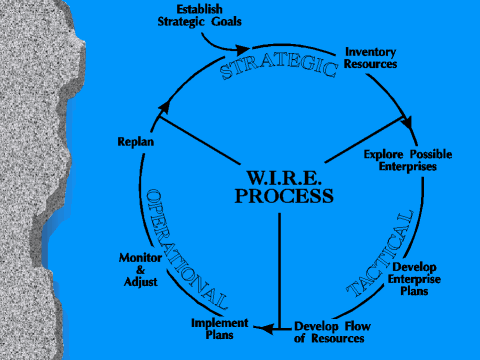While the WIRE process
doesn’t yield fool-proof prescriptions for success, it does help us find possible
answers and pare those possibilities down to workable solutions We begin with goals,
because we feel these really drive the process.- We look at goals for: for the
operation, for family, for leisure time, also other family members, employees, etc...
- We also assign costs to each of the goals,
Next we look at the resources of the operation--in 5 categories
- Wildlife resources: Game and non-game species
- Human resources: Operator, operator's family, hired labor, neighbors, owner, etc.
- Financial resources: Cash, stocks, crop inventories, buildings, improvements, land, etc.
- Livestock resources: Cattle, sheep, horses, etc..
- Basic resources-Natural and Agronomic: Soil, air, water, native plants, fertility,
climate, etc.
Once goals and costs are known we look for ways to better utilize our resources--our
competitive advantage—this is essentially an analysis of "how" we plan to
get from where we are to where we want to go.
1. First we look at the field of possible enterprises for alternatives
2. Next, we develop an enterprise analysis of our current operations, resources demanded,
and SWOT assessment in order to find additional resource constraints or competitive
advantages
3. Finally, we look at our existing set of resources and whether or not we have enough
to handle what we are already doing plus a new enterprise using resource flow plans. This
includes an analysis of net returns from the primary enterprise using enterprise budgets,
as well as setting tactical goals and benchmarks.
Once we've formulated a workable plan, we implement it.
We monitor and adjust as necessary as we go along.
And, we evaluate the performance of our operation at some point each year in order to
replan for the coming production cycle.
